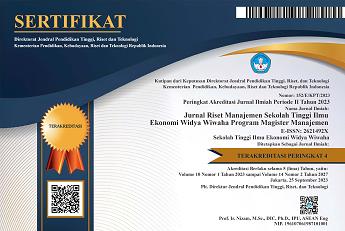BIAYA LINGKUNGAN DAN DAMPAKNYA DALAM PENENTUAN HARGA JUAL
Studi Kasus di Galaxy Waterpark Yogyakarta
DOI:
https://doi.org/10.32477/jrm.v11i1.748Keywords:
Environmental cost, Clasification, Impact, Selling PriceAbstract
One of the importance of environmental accounting for companies is the allocation of environmental costs, in this case the environmental costs presented in financial reports can show the real costs used in maintaining and managing the company's environment. Therefore, the aim of this research is to determine the classification and recognition of environmental costs due to waste management costs at Galaxy Waterpark, as well as to see the impact of environmental cost recognition on selling price calculations. The analytical method used is descriptive qualitative. The data in this research was obtained through interviews, observation and documentation compared with the classification theory of the environmental costs and Basic Framework for Presenting Financial Reports in SAK as well as the way companies use selling price calculations. Based on the research results, it can be seen that Galaxy Waterpark classification of environmental costs is not in accordance with Hansen and Mowen's theory, and the recording of environmental costs does not follow the Basic Framework for Presenting Financial Reports in SAK. This is evident from the presentation of environmental costs recorded in one space, namely expenditure costs in the profit and loss report (normative model). Recognition uses a cash-based method and does not apply recognition from Basic Framework for Presenting Financial Reports in SAK. To calculate ticket selling prices, we use the margin pricing formula, which indirectly involves operational cost components, which include environmental costs. So environmental costs are also a consideration in determining the selling price.
References
Adistyawati, C. (2018). Analisis Efisiensi Biaya Lingkungan Dalam Upaya Meningkatkan Kualitas Pengolahan Lingkungan.
Aniela, Y. (2012). Peran akuntansi lingkungan dalam meningkatkan kinerja lingkungan dan kinerja keuangan perusahaan. Berkala Ilmiah Mahasiswa Akuntansi, 1(1), 15–19. http://jurnal.wima.ac.id/index.php/BIMA/article/view/24
Kemala, A. (2013). Pemahaman Kerangka Dasar Penyusunan. Media Riset Akuntansi, Auditing & Informasi, 13, 59–79.
Kusnianti, E. (2013). EKSISTENSI TRADISI NYADRAN DI GUNUNG BALAK DALAM ARUS GLOBALISASI. 2–3.
Laksono, T. D. (2021). ANALISIS PENERAPAN AKUNTANSI LINGKUNGAN DI RUMAH SAKIT UMUM PUSAT DR. SARDJITO YOGYAKARTA. 154115377, 1–95.
Mulyani, N. S. (2013). Analisis Penerapan Akuntansi Biaya Lingkungan Pada Pabrik Gondorukem dan Terpentin (PGT) Garahan - Jember. Skripsi, 57(4), 1–55.
Pratama, A. (2017). PENGARUH BIAYA PRODUKSI TERHADAP HARGA JUAL (Studi Kasus Pada Perusahaan Makanan Kue Lintang Tasikmalaya). 1–23.
Prayogo, N. umar. (2021). ANALISIS FRAMING ROBERT N ENTMAN PADA PEMBERITAAN HOAX SEPUTAR “VAKSIN COVID 19” DI MEDIA ONLINE LIPUTAN 6.COM DAN KOMPAS.COM PADA 22 JUNI DAN 18 FEBRUARI 2021.
Ratih, M. (2018). Pengakuan Biaya Lingkungan Dan Dampaknya Terhadap Penentuan Harga Jual.
Sari, S., Sudjana, N., Farah, D., Fakultas, A., & Malang, I. A. (2013). PENERAPAN AKUNTANSI LINGKUNGAN UNTUK MENGOPTIMALKAN TANGGUNG JAWAB INDUSTRI GULA (Studi Pada PT Perkebunan Nusantara X Unit Pabrik Gula Lestari Nganjuk). Jurnal Administrasi Bisnis (JAB)|Vol, 2(1).
STEM. (2021). Cara Menghitung Harga Jual Dengan Benar. 25 Januari 2021. https://www.sterling-team.com/news/cara-menghitung-harga-jual-dengan-benar/
Yudhistira. (2022). 5 Cara Menghitung Rumus Harga Jual untuk Produk Anda. 19 Maret 2022. https://www.bhinneka.com/blog/rumus-harga-jual/
Downloads
Published
How to Cite
Issue
Section
License
Copyright (c) 2024 Lilik Ambarwati, Gusmila Lovnia Erawati

This work is licensed under a Creative Commons Attribution-ShareAlike 4.0 International License.









